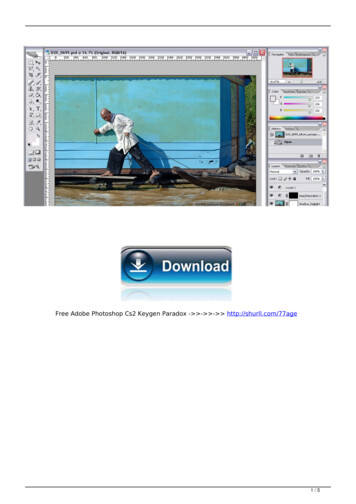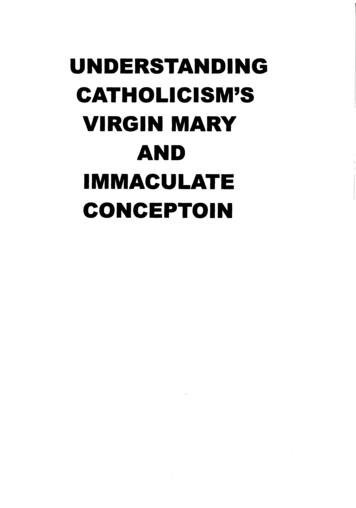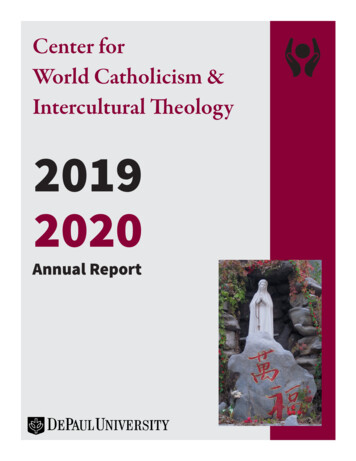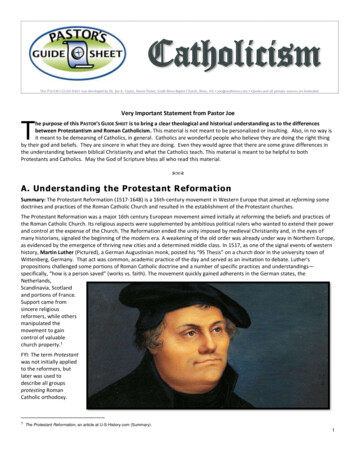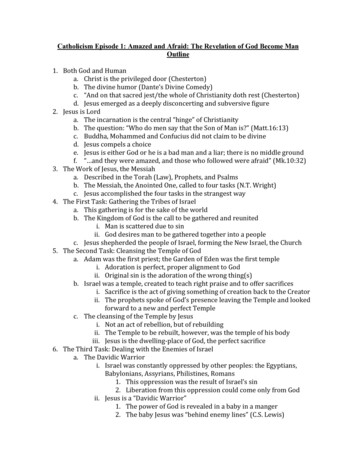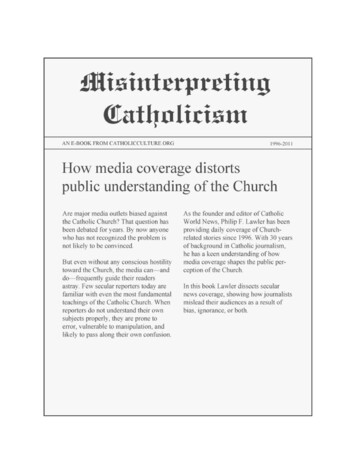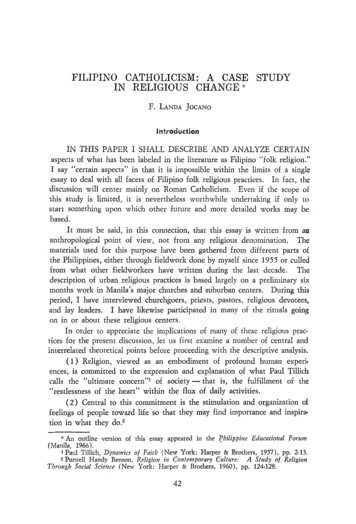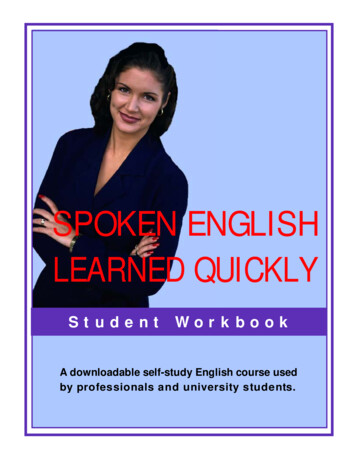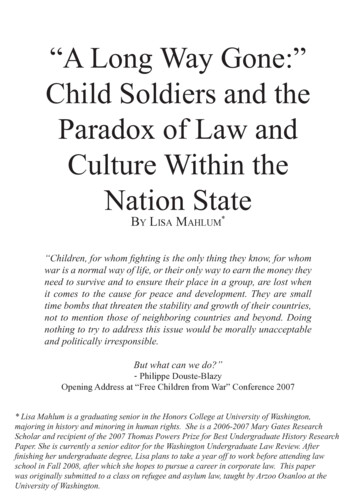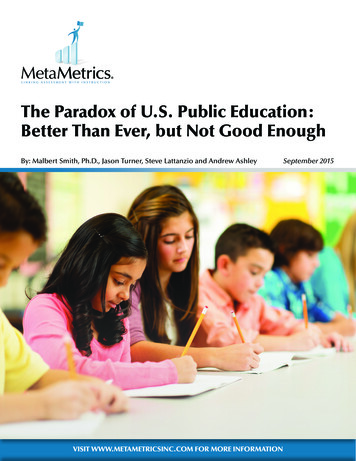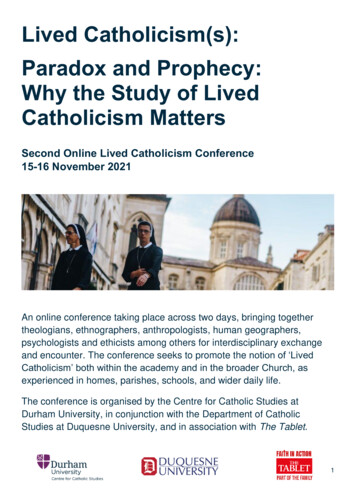
Transcription
Lived Catholicism(s):Paradox and Prophecy:Why the Study of LivedCatholicism MattersSecond Online Lived Catholicism Conference15-16 November 2021An online conference taking place across two days, bringing togethertheologians, ethnographers, anthropologists, human geographers,psychologists and ethicists among others for interdisciplinary exchangeand encounter. The conference seeks to promote the notion of ‘LivedCatholicism’ both within the academy and in the broader Church, asexperienced in homes, parishes, schools, and wider daily life.The conference is organised by the Centre for Catholic Studies atDurham University, in conjunction with the Department of CatholicStudies at Duquesne University, and in association with The Tablet.1
Day 1: Monday 15 November14:00-19:30 GMTSession 1: 14:00-15:20 GMTWelcome and Introduction from Avril Baigent (Chair of ConferenceOrganising Team) and Professor Mathew Guest (Head of Department ofTheology and Religion, Durham University)Opening PlenaryParadox and Prophecy: Why the Study of LivedCatholicism MattersSpeaker: Professor Massimo Faggioli, Villanova UniversityChair: Dr Marcus Pound, Durham UniversityConcluding word: Professor Paul D. Murray, Dean-Director, Centre forCatholic Studies, Durham UniversitySession 2: 15:35-16:45 GMTSites of Paradox and Prophecy: Short Papers Part OneParticipants are invited to select a stream to join. Comments and responses can be submitted via chat. Ineach stream, each 15-minute paper will follow straight on from the last, with discussion of all three paperstaking place afterwards.Stream 1Stream 2Stream 3Stream 4Catholic Women andSexualityCatholic WomenProphetic in OrdinaryHealthEducationChair:Dr Anna NiedźwiedźChair:Prof Lisa LickonaChair:Dr Marcus PoundChair:Dr Claire Jenkins2
Dr Sarah-Jane PageAston UniversityDr Pam LoweAston UniversityA QualitativeInvestigation intoBritish CatholicAbortion Attitudes:Lived Religion,Nuance andComplexitySurvey research hasalready revealedincreased liberalisationon abortion attitudesamong BritishCatholics in recentyears (e.g. Clements2014). This projectutilises a qualitativeapproach to investigatein more detail attitudesin the British context,drawing on in-depthinterviews with bothpriests andparishioners. Thisresearch utilises a livedreligion approach tounderstand the nuanceand complexity ofattitudes,demonstrating theimportance of livedexperience ininfluencing opinion. Wewill present theseattitudes as acontinuum, rather thana dichotomy, with a keyfinding thatparishioners whostrictly adhere to officialChurch teaching onabortion are in aminority.Dr Pat JonesDurham UnversityDr Peter KevernStaffordshire University‘Be proud to be aworker girl’: Theimpact of YCW onworking classCatholic girls in thepost-war eraBetween suicide andadoration: reflectionson online devotionsduring lockdownThere has been asignificant rise in theThe dominant message popularity of onlinegiven by CatholicAdoration of the Blessedteaching to womenSacrament since theabout their vocationsclosure of churches tohas always leanedregular worship in theheavily into the models early days of the Covidof marriage,19 pandemic. Thismotherhood andappears to be a responseconsecrated life.from the faithful thatexpresses or salves theCatholic women wereexperience of distancenot so easily confinedand exclusion fromto these essentialisingaccustomed patterns ofroles as papal teaching worship with a ‘sociallyintended. This paperdistanced’ form ofexamines how somedevotion to the Divineyoung working-classPresence.Catholic girlstenaciously pursuedThe paper begins withother possibilities. The the assumption that thisYoung Christianis an authenticWorker (YCW)expression of themovement took root inCatholic sensus fideliumEngland and Walesrather than a theologicalbefore the war, but itsand devotional error.expansion happenedDrawing on the work ofafterwards. Based onthe French philosopherarchive research andJean-Luc Nancy, andinterviews, I show how particularly his account ofsome working-class‘The Deconstruction ofwomen discovered aChristianity’, it develops asocial and politicaltheoretically-informedmission through YCW. analysis that hasimplications for ourunderstanding of themeaning of ‘DivinePresence’ in the postlockdown era.Dr Fiona DineenMary ImmaculateCollegeSites of Paradox andProphecy: Educators,Ethos and the livedreality of the CatholicschoolCatholic education inIreland is currentlyundergoing a period ofimmense challenge andchange. Recenteducational discourseand policy changes,while providing positiveopportunities, also createan increasingly complexoperational landscape forCatholic schools. Thispaper will address theimplications of thesechallenges and explorecritically how educatorsmediate the mission andvalues of Catholiceducation into the livedreality of their schoolcommunities, drawing onthe findings of recentresearch in this area. Itwill particularly focus onthe evolving nature ofreligious education inprimary schools, withspecific reference to therole of the educator interms of their religiousliteracy, identity andprofessionaldevelopment.3
Mr Luis BastidasMenesesUniversity of BayreuthMs Claudia ÁlvarezHurtadoBoston UniversityCatholicism withoutthe Catholic Church.The case of Católicaspor el Derecho aDecidir movement inColombiaRegardless of theCatholic Church’sopposition tocontraception since the1960s, many Catholicsreconfigured their faithwithout a conflictbetween contraception,sexual practices, andways of living the faith(Bastidas & Beltrán,2019). Thispresentation examinesa renewed tensionbetween institutionaland individualexperience in Colombiathrough the lenses oflived religion (McGuire,2008; Ammerman,2020) and feministtheology (RadfordRuether, 2008). TheCatólicas por elDerecho a Decidir(Catholic Women forChoice) movementfight for women’sreproductive rights andagainst the risk of legalprosecution due toabortion beingconsidered a crime(González-Vélez &Castro, 2021). Basedon a feministtheological perspectivetheir struggle is rootedin religious principlesMs Evyn McGrawUniversity of StAndrewsHow the Stories ofFlannery O'ConnorCan Heal a DividedChurchThough FlanneryO’Connor wrote torouse the complacentChristians of themidcentury evangelicalAmerican South, herstories are still relevantto the problems of thecontemporary Church.This paper proposeshow her stories mightheal the ever-growingfactionalism betweenvarious strands of socalled “traditionalism”and “modernism.” Bothreactionarytraditionalism andliberal modernism offertheological systems ofgrace and ecclesiologythat displayfundamental failures toattend to the actuallived reality of grace.This failure of attentionmisunderstands theways grace operates inthe world and runs therisk of blindingindividuals to theperson of Christ.O’Connor reminds usof who Christ is byillustrating the livedexperience of gracethrough her stories,revealing that God’sgrace is disorienting,gratuitous, oftensubversive, andincapable of reductionto a theological“system.” This paperDr Luke BuhagiarDISCERN(www.discern.mt)Dr Matthew PulisUniversity of MaltaAndre ZaffareseArchdiocese of MaltaLived Catholicism andCovid-19: Perspectivesof parish priests andparish workers in MaltaCovid-19 has precipitatedfundamental changes inpeople’s experiences ofLived Catholicism(s).This presentationconcerns a qualitativestudy that looked at theperspectives of parishpriests and parishworkers on the effects ofthe Covid-19 pandemicon parishes in Malta.Semi-structuredinterviews wereconducted with 8 parishpriests and 10 parishworkers across differentparishes, and the datawere analysed usingthematic analysis. Thefindings shed light on thedynamics involved in anever-changing LivedCatholicism. Thispresentation looks at fivekey patterns thatemerged acrossparticipants’ arguments.These concerned (a) layidentities andecclesiologies, (b)diaconia, (c) spiritualneeds, (d) mass andSacraments, and (e)parishprofessionalisation. It isargued that anunderstanding of theshifts in these domains isinseparable from anDrs Isaak DemanKU Leuven / AustralianCatholic UniversityLived Catholicismthrough CatholicEducation?Pre-ConciliarExpectations amongthe European Bishopsas reflected in the VotaIt is well-known that theCatholic Churchemphasizes the need forCatholic education touphold and pass ondogmatic truth-claimsand a social teachingthat co-aligns with theChurch’s vision for theworld. In the wake ofVatican II, GravissimumEducationis (GE)touched upon this issuebut it did not receivemuch attention incontrast to other conciliardocuments. Moreover, itgarnered mixedresponses. But ratherthan looking at GE or itsreception, this paperinvestigates howEuropean bishops(possibly the UKincluded) envisionedCatholic education priorto the Council, namely, inthe VotaAntepraeparatoria.Employing comparativeanalyses, this paperexplores how theseexpectations aboutCatholic educationinforms the conceptualframework of livedCatholicism.4
acknowledgingwomen’s dignity andagency over theirbodies and lifeprojects. With this casewe look for answers tothe question of how,while the influence ofthe church seemsweaker, Catholicreligiosity finds ways toretain their force inpeople’s lives. Even ifthis entailsincorporating moralissues once consideredundoubtably immoral.pays special attentionto O’Connor’s story“The Temple of theHoly Ghost” to illustratethe disruptive reality ofgrace.understanding of LivedCatholicism as a whole.Ms Eline HuygensGhent UniversityDr Terry TastardCadbury Centre forPublic Understandingof Religion,Birmingham UniversityProf. Daryl HigginsAustralian CatholicUniversityDr Damian CostelloNAIITS: An IndigenousLearning CommunityDesigning a newsafeguarding systemfor Catholic Churchentities in AustraliaInnovation from thePeriphery: Lessonsfrom Black Elk and theIndigenousCatechetical Traditionin the Context ofAntique MinisteriumGender,relationships, andsexuality. Anempirical study onthe lived experiencesof young Catholicwomen.My PhD project issituated in theinterdisciplinary studyof gender and religion,and takes the lives ofyoung Roman Catholicwomen who are activein the Church inBelgium as a startingpoint in order toexamine how religiosityis constructed andperformed. I investigatehow these womennavigate betweenreligious traditions andprescriptions on theone hand, and secularsociety on the other. Indoing so, I seek toexplore how religiousbeliefs and teachingsinform theirinterpretations,experiences, andFlorenceNightingale's LoveHate Relationshipwith the CatholicChurchBefore the CrimeanWar catapulted her tofame, FlorenceNightingale wasfascinated with theCatholic Church. Thenursing work ofwomen’s apostoliccongregations seemedto offer her agency andfulfilment. After the warher feelings changed.At Scutari andBalaclava Nightingalehad clashed with theIrish superior of theSisters of Mercy. Incorrespondence andpublic testimony afterthe war Nightingalewas negative aboutreligious sisters andthe Irish, part of abroader antipathyThe Institute of ChildProtection Studies atAustralian CatholicUniversity was asked bythe Australian EpiscopalConference of theRoman Catholic Church,together with CatholicReligious Australia toreview the needs of theCatholic Church inAustralia regarding thesafeguarding of children,young people andvulnerable persons. Weundertook a mappingexercise and designed anational safeguardingoperational model for theproject. We reviewedexisting safeguardingregulatory obligationsand the needs,opportunities andchallenges in providingsafeguarding serviceswithin the Church. WhileIn Antiquum Ministerium,Pope Francis restoredthe lay ministry ofcatechist. This paperexplores how Francis isfollowing the 500-yearwitness of livedIndigenous Catholicism.Through the lives ofNicholas Black Elk andother Indigenouscatechists, we willexamine how IndigenousCatholics expanded thescope of lay leadershipwithin the Church byadopting on the onehand emphases fromevangelical forms ofProtestantism, such aslay bible study andrevival-type gatherings,and on the otherIndigenous wisdom and5
practices pertaining tofemininity, intimaterelationships andsexuality. Based uponethnographic research,inspired by a livedreligion approach, Ishow how these youngwomen inhabit bothCatholic and secularethics, and how bothCatholic and seculardiscourses are enactedin their lives.towards the CatholicChurch. This wasmitigated by herfriendship with anothersuperior of Sisters ofMercy who had nursedin the war, Mary ClareMoore, whoencouragedNightingale to read arange of mysticalwriters. However,Nightingale’sinterpretation ofmysticism was closerto the Unitarianism ofher ancestors in itsemphasis on humanwillpower, and far froma conventional Catholicunderstanding Evenso, her study of themystics also shows anenduring ambivalencetowards Catholicism.many Catholic Entitieshad developed systemsand processes designedto prevent and respondto abuse, there was aneed for more targetedguidance and support toensure a consistentapproach to theprevention of—andresponse to—abuse. Thedesign of the nationalsafeguarding operationalmodel was informed bystakeholder consultationsand an analysis of therecommendations of theAustralian Government’s2013 Royal Commissioninto InstitutionalResponses to ChildSexual Abuse. Theproposed operationalmodel was for theestablishment of a newnational office to overseeand coordinate theconsistency, quality,efficacy and coverage ofsafeguarding andprofessional standardservices across theChurch. The proposedmodel was accepted andis now beingimplemented. Its role isto equip and supportChurch Authorities tocontinue theirsafeguarding journey anddrive culture changewithin theirmembers/entities.practices deemed bynon-Indigenous to beoutside the scope ofCatholic faith, particularlyhealing work and sacredrelationality with the nonhuman world. Indigenouscatechists forged aninnovative role thatscrambled traditionalCatholic understandingsof ministry whileremaining firmly withinthe Church. From thisperspective, AntiquumMinisterium represents aform of reverseevangelization, wherebythe lived Catholicismfrom the peripheryinfluences a Church inneed of renewal.Session 3: 17:00-18:00 GMTLived Catholicism in Postsecular SocietySpeaker: Dr Michele Dillon, University of New Hampshire6
Chair: Dr Pat Jones, Durham UniversityFollowed by questions and responses submitted via chat.Session 4: 18:30-19:30 GMTPop-Up PodiumTwo streams of poster presentations. Participants are invited to select a stream to join. In each stream, the5-minute poster presentations will be shown consecutively and then there will be time for discussion.Comments and responses can be submitted via chat.12Chair: Avril BaigentLearning and Living SynodalityChair: Prof Paul D. MurrayDr. Kathryn LamontagneBoston UniversityProf Paul D. MurrayDurham UniversityGender, Faith, and Class: LivedCatholicism in Massachusetts, 1950-1955Introduction: Synodality and LivedCatholicismMy new research on lay Catholic womenseeks to investigate the Lived Catholicism oflay women in the Flint neighborhood of FallRiver, Massachusetts in the early 1950s through the lens of ethnicity and class.I am making use of the collection of SarahCroskery Pelletier’s recently discovered dailyletters and ephemera, which provide valuableinsights into the vibrant Lived Catholicism ofa first-generation, working class NorthernIrish-American in New England.Mrs Anne Marie O'RiordanMargaret Beaufort Institute of TheologyMr Raphael YabutBoston CollegeCapturing Voices – A TheologicalListening EthicLearning With One Another: LivedPedagogies in Grassroots ChurchCommunitiesIn my last pop-up presentation, I introducedthe research I had begun to embark on,which is the exploration of RC womenchaplains’ understanding of self and Godwithin ministerial practice. I ended myThe practices and stories of basic ecclesialcommunities in the Philippines present animplicit pedagogy where members learn withone another for social justice in their7
3presentation by saying that what I wouldneed to address next was how to capturetheir voices. I would like to consider thismethodological aim and suggest that in orderto capture the voice of the other, it is equallynecessary to be able to listen well. Therefore,for this presentation I will present a flavour ofa theological listening ethic I have begun todevelop, which draws upon the Ignatiantradition, as one way of hearing not only thevoices of my research participants, but alsoGod’s voice as well as my own.neighborhoods in the context of the current waron drugs. This pedagogy embodies a synodalreligious education that listens to the sense offaith of the members in their everyday lives,involves all in participation and consultation, andpromotes transformative learning for socialchange. Using both participatory actionresearch and ethnographic research methods,my study attempts to flesh out this pedagogyfurther. What this process shows is a more coconstructive way of studying lived Catholicism:aiming to describe what is already happening onthe ground and, together with the community,imagine ways moving forward as a church.Mr Jake GrefenstetteUniversity of CambridgeDr Pat JonesDurham UniversityLived Catholicism and Catholic Poetry: ACase Study in Gerard Manley HopkinsThe Goad of the Promised Future:Reflections on 40 Years of Consulting theBaptised from the Liverpool 1980 CongressOnwardsWhat does Lived Catholicism have to say tothe interdisciplinary study of theology andliterature? This paper explores possibleapproaches through a case study of GerardManley Hopkins’s ‘I wake and feel the fell ofdark, not day.’ My five-minute paper surveysthe history of responses to what WilliamEmpson identifies as the problem of paradox(or ‘seventh-type ambiguity’) in the poem. Iwill focus specifically on the ways in whichthe challenging metaphor of ‘dead letters’ hasbeen read in light of the Jesuit’s livedexperience of the priesthood.4The Synodal process now initiated by Francis isnot the first church-wide process of listening thathas taken place in this local Church. For 40years since the Council, hopes have beenraised and often lost as diocesan and nationallevel events and processes have tried toengage all the baptised in what we can nowrecognise as synodal experiments. I will brieflyexplore what we can learn from this livedexperience to identify pitfalls, risks and potentialas we seek to inhabit a newly enrichedunderstanding of synodality.Ms Allison GuerretteDuquesne UniversityMr Christopher LambThe Tablet and Durham UniversityIt is the Spirit Who gives Life: LivingCatholicism Boldly and DynamicallyReshaping the Centre: A Synodal Rome?Understanding the Church Past allows us tomore authentically be the Church Presentand Future. For my pop-up podium, I will lookback to the lived faith of the Apostles andexamine how such a model—one ofcommunity living and radical openness to theHoly Spirit—builds and strengthens the Bodyof Christ. My research will explore how thesetwo aspects of Catholic life affect both theThis reflection will look at whether the Pope'ssynodal reforms are shaping the culture andpractice of the Roman Curia, with a particularfocus on the Synod of Bishops' office and thelaunch of the global synod process in theVatican last month. I will examine some of theresistance to Francis' reforms and argue thatthe 2023 synod requires both a clear sense ofdirection from head office along and a8
5study and practice of Lived Catholicism. Myanalysis will begin by looking to the history ofthe Catholic Charismatic Renewal in theU.S.—which started with DuquesneUniversity students in 1967—as well as thepresent revival of the Spirit on the campusand its effect on students and faculty. Thestudy of Lived Catholicism reveals thecharismatic beginnings of the Church,opening hearts and minds to thetransformative power of the Holy Spirit—Whois just as present in this age.willingness to be transformed by the experienceof the local churches.Mr Bartosz ArkuszewskiJagiellonian University, Museum of KrakowProf. Peter McGrailLiverpool Hope UniversityThe Material Medium of Healing. Casestudy of the oil in the worship of SaintCharbel in Krakow (Poland)Is Anything Off the Synodal Agenda?The recent Liverpool synodal process offeredpeople the opportunity to raise their hopes,Monthly devotions to Saint Charbel in Krakow concerns and aspirations for the future directionof the Archdiocese. Included in the responses(Poland) have been gathering devotees ofwere issues and proposals that lie beyond thethis saint for 10 years. One of importantcanonical remit of a diocesan synod. In thiselements of the cult is the oil of Saintpaper I shall examine some of these voices, andCharbel. According to worshipers the oil ofask what lessons we might take from listening toSaint Charbel heals diseases of the body,mind and soul. There are a lot of testimonies them.of healings by the oil of Saint Charbel.The oil of Saint Charbel is a valuable item.The faithful try to get the oil of Saint Charbelat devotions and communicate the oil to eachother. Followers also form a network todistribution of the oil of Saint Charbel. In theopinion of faithful the oil of Saint Charbelbecomes a material medium of healing.Through this oil worshipers religiouslyexperience their sufferings, diseases andhealings.6Mrs Ma. Adeinev (Nev) Reyes-EspirituKU LeuvenDr John O’BrienDurham UniversityOwning One’s Faith: An Inquiry into thePractice of (Catholic) Christian Faith byPhilippine Transnational MothersDialogue: Easy to Say; Difficult to Do!Transnational mothering is one effect of labormigration as experienced by many Philippinewomen. In an ongoing study involvingPhilippine transnational mothers, (Catholic)Christian faith appears to be a significantresource that supports mothers’ efforts toThe Synodal journey in Ireland will involveongoing encounter, dialogue, and discernment and daily conversion. One illustration of thechallenge involved is the tortuous discussionfrom 2010-2018 between the Irish Bishops andthe Association of Catholic Priests (ACP) - twocommitted groups, each desiring the good of the9
strategize to gain access to a better life forthemselves and their kin. They narrateexperiences of God’s presence in their liveswhich motivate their choice to invest in faith.A significant component of this process ofinvesting in faith is a concept I call prioritizingfaith wherein mothers exhibit expressions of(Catholic) Christian faith that adapt to theircontext. For the participant mothers,prioritizing faith opens up to the possibility ofnegotiating with God. These processesreinforce the value of (Catholic) Christianfaith to women who navigate the complexitiesof transnational mothering as labor migrants.This observation is based on their reports ofexperiencing transformation that allow themto survive, to overcome challenges, and topursue their central aim of gaining a betterlife.Church, who found encountering each otherneuralgic.DiscussionDr Gregory RyanDurham UniversityMaking Room and Making Sense in a Messyand Synodal ChurchSeen from a certain perspective, the currentworldwide synodal process(es) might beconsidered as a giant experiment intheologically-interested Lived Catholicism. Asan academic working in ecclesiology, butpracticing that theology in settings of localecumenism, parish and diocesan life, andformation for lay and ordained ministers, thissynodal intersection of Lived Catholicism andsystematic/fundamental theology suggests anumber of questions and possibilities forpresent and future research. This pop-uppresentation makes an initial exploration ofsome of these as a contribution to the specificforum on synodality, and a wider conversationon the relationship of systematic theology andLived Catholicism.Discussion10
Day 2: Tuesday 16 November11:00-19:00 GMTSession 5: 11:00-12:30 GMTTheology and Paradoxes: Discerning Prophetic Voices in anHonest Ecclesiology for the Whole-ChurchSpeaker: Dr Clare Watkins, Roehampton UniversityChair: Gaël Pardoën, Durham UniversityFollowed by questions and responses submitted via chat, and breakoutgroups.Session 6: 13:15-14:30 GMTSites of Paradox and Prophecy: Short Papers Part TwoParticipants are invited to select a stream to join. Comments and responses can be submitted via chat. Ineach stream, each 15-minute paper will follow straight on from the last, with discussion of all 3-4 paperstaking place afterwards.Stream 5Stream 6Stream 7Stream 8Paradox andBelongingAbuseCross CulturalEngagementsCulture & DevotionChair:Mr Adrian BrooksChair:Dr Marcus PoundChair:Dr Damian CostelloChair:Prof. John EadeMr Gaël PardoënDurham UniversityDr Matthias DickertComenius UniversityBratislavaMiss TiffanyHunsingerUniversity of DaytonDr Héctor Varela RiosVillanova UniversityThe case of the Duplessis Orphans asone of the first andneglected cases ofPure CatholicEvangelicals: TheShaping of ModernUnsettling/edbelonging, systematicecclesiology learning"Depicting heavenlyreality": works of artas documents of belief11
from LivedCatholicismDeveloping the work ofTricia Bruce and othersin the field of ParishStudies, I explore hownegative theology, aswell as 'dissent' as'ecclesial principle'(Judith Gruber), canhelp us engage with'lived Catholicism'theologically i.e.,receptively, critically,and constructively.child abuse within theCatholic Church afterWorld War TwoThe Catholic Churchhas recently been hit byscandals of child abuse.It was countries likeAustralia, Germany,Ireland or the USAwhere laymen andclergymen ( also nuns)were accused of havingmisused childrenphysically, mentally andsexually . Thissystematic abuse wasoften ignored or eventolerated by ChurchI explore theofficials who oftentransformations of livedprotected the accusedecclesial belongingrather than the victims.through the mutations of One of the first scandalsthe parochial system inbeing publicly discussedthe US, leading to what I was the case of the socall ‘unsettlingcalled Duplessisbelonging’. I then argue orphans which shockedin favour of anCanada and the rest ofthe world in the 1940sapophatic theology ofand 1950s . Howeverecclesial belonging,the accusations werewhich is opened to theoften not followed bygreater fluidity in whichecclesial commitment is consequences thushinting at the close linklived out without puttingbetween church andChristian doctrine aside.state in the QuebecBetween affirmationsarea as a Catholicand negations, it allows stronghold within thefor the articulation ofROC. The lecture willecclesial paradoxes.throw light at thisFinally, an apophaticspecific case and triesto reflect matters of childtheology of belongingabuse in general andleaves us with a sensewithin the Catholicof frustration, evenChurch in particular. Itfailure, and indeedwill also pose questionsunsettlement which, Iwhy the accusationsargue, is necessary forwere not followed bythinking, and indeedany consequences, aliving, a (pretendency which can stilleschatological)be found today.prophetic andnecessarily unsettledecclesial belonging.Catholicism's PurityCultureIn this paper, I willexamine the role ofevangelicalism in themodern Catholiccontext, specificallythrough the lens ofpurity culture. I wish toconvey that evangelicalpurity culture hasinfluenced many youngadult Catholics. Thisculture has evolved toinclude more and moreevangelical vocabularyand identifiers. Are theeveryday practices ofCatholics within thismovement beginning tolook more likeEvangelicals thanCatholics? How can werespond as the worldencounters moreCatholics influenced byEvangelical texts suchas John Eldridge's Wildat Heart and wearingpurity rings almost assacramentals? Thispaper will treat Catholicpurity as intertwinedwith Evangelicalmovements and thusoffer outside factorsbeyond currentscholarships on insideCatholic influence.That religious objectsdocument religion isusually construed asfact. In this paper, I alsoconfirm that fact via‘object stories’ ofbelievers, that is, thecomplex and diverselived religion displayedthrough theirrelationships withreligious objects. But,what is *it* that religiousobjects document?Since the key word isdocument, I begin withMaurizio Ferraris’“documentality” and itsconstitutive rule “Object Inscribed Act.” I alsorealized during theinterview process thatmy informants weredescribing andexplaining beliefs invarying ways. Toelucidate, I turn to DavidMorgan’s typology ofbelief. Construing beliefas a social act, Iformulate the ‘FerrarisMorgan’ constitutive ruleof religiousdocumentality: ReligiousObject InscribedBelief. My informants'witness suggest thatthese objects aredocuments of belief:belief rediscovered,belief nurtured, beliefdistributed, belief used,belief identified – belief‘depicted’, as oneinformant said. Yet, howauthentic are thesedocumentalities ofbelief? I use Orlando O.Espín to authenticatethe “sensus fidei”depicted in thesereligious documents.Espín will also behelpful to ascertain whatis at stake, for one, thesubversiveness theypresent to the study oflived Catholicism and to12
'official' Catholicism ingeneral.Dr Florian KlugJulius-MaximiliansUniversität WürzburgThe aesthetics of theEucharist: A paradigmfor coping withambiguityConsidering theEucharist regardinglogical identity, we haveto recognize a paradox.The objective surfaceappears as unchangedbread and wine, whilethe Catholicunderstanding perceivesthe Eucharist as thebody and blood of JesusChrist due totransubstantiation.Instead of adhering tocurrent ideologicalfragmentations andbinary conceptions, wecan depict the Eucharistas a school of aestheticunderstanding thatmakes it possible tocope with ambiguity andavoid self-enclosedunderstandings. Byrefusing to provide anabsolute definition, theEucharist provides ameeting point thatbrings together differingmeanings and letscontradicting positionsof inside and outsidestay in peacefulcoexistence.This paper will elaborateon how the Eucharist isstill one of the keyaspects ofcontemporaryCatholicism and offersaesthetic and reflexiveProf Lisa LickonaSaint Bernard's Schoolof Theology andMinistry, New YorkNoli me tangere: T
understanding of Lived Catholicism as a whole. Ms Eline Huygens Ghent University Gender, relationships, and sexuality. An empirical study on the lived experiences of young Catholic women. My PhD project is situated in the interdisciplinary study of gender and religion, and takes the live

